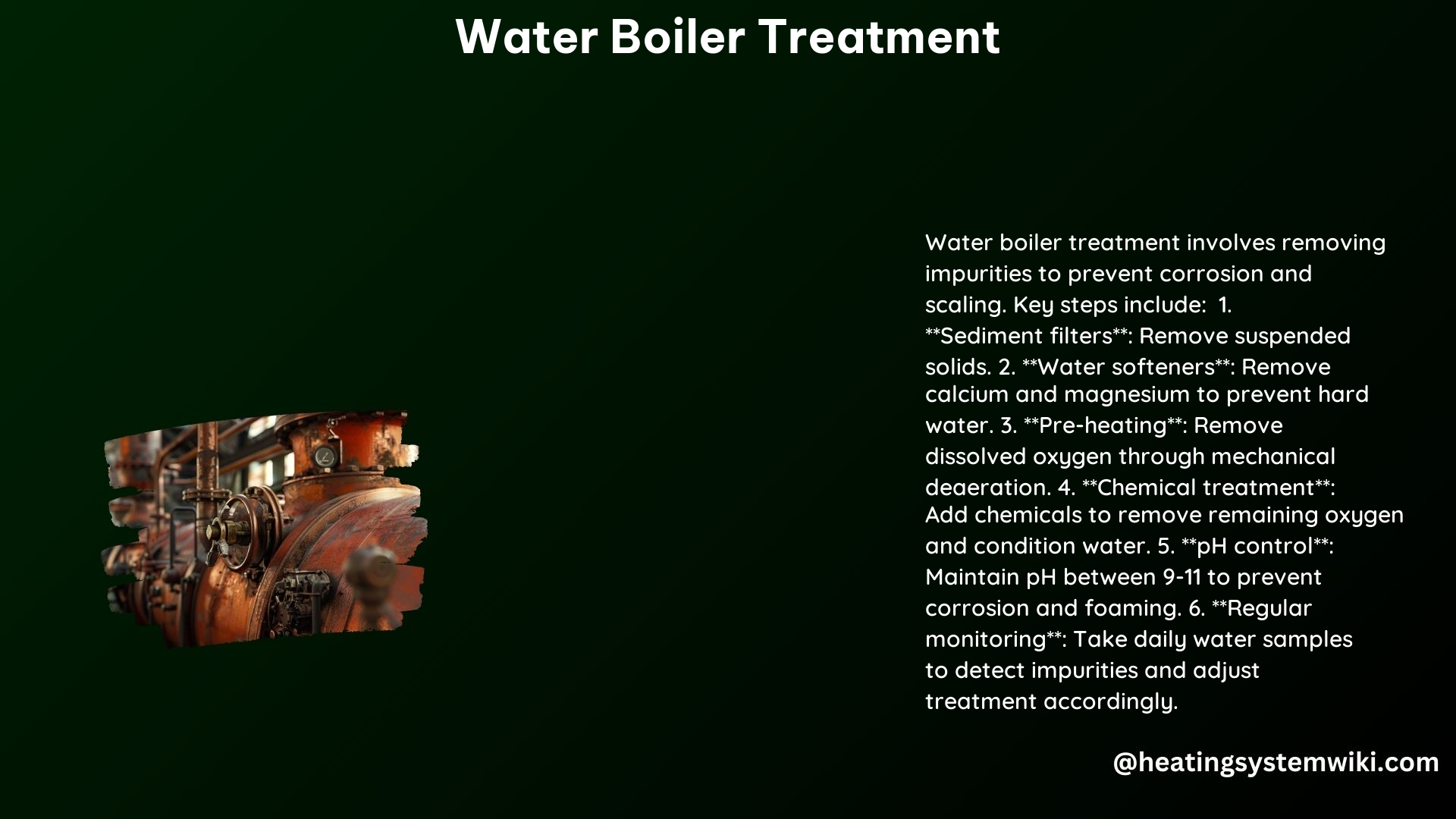Water boiler treatment is a critical process that ensures the optimal performance and longevity of steam boilers. It involves conditioning and treating boiler feed water to maintain a clean and efficient heat transfer process, prevent corrosion and scaling, and produce high-quality steam suitable for various industrial applications.
External Treatment: Preparing the Feed Water
-
Water Softening: Removing calcium and magnesium ions from the feed water is crucial to prevent scale formation. This is typically achieved through ion exchange, where sodium ions replace the calcium and magnesium ions. The softened water should have a hardness level of less than 0.3 parts per million (ppm) to effectively prevent scale buildup.
-
De-aeration: Dissolved oxygen in the feed water can lead to corrosion of the boiler’s metal surfaces. De-aeration involves heating the water to remove dissolved gases, typically to a level of less than 0.007 cubic centimeters per liter (cc/L).
-
Pre-treatment: Depending on the feed water quality, additional pre-treatment steps may be necessary, such as filtration, reverse osmosis, or evaporation. These processes can remove suspended solids, dissolved salts, and other impurities, ensuring the feed water meets the required specifications.
Internal Treatment: Conditioning the Boiler Water

-
pH Control: Maintaining the boiler water pH within the optimal range of 9-11 is crucial to prevent corrosion and foaming. This is typically achieved by adding chemicals like sodium hydroxide or trisodium phosphate to the boiler water.
-
Oxygen Scavenging: Residual dissolved oxygen in the boiler water can lead to corrosion. Chemicals like sodium sulfite or hydrazine are added to the boiler water to react with and remove the dissolved oxygen.
-
Scale Prevention: Softening agents like sodium phosphate and soda ash are added to the boiler water to condition the impurities and prevent the formation of scale on the boiler’s metal surfaces. The target concentration of these softening agents is typically between 30-60 ppm.
-
Corrosion Inhibition: Corrosion inhibitors, such as amines or nitrites, are added to the boiler water to form a protective film on the metal surfaces, preventing corrosion.
Chemical Treatment: Maintaining Water Quality
-
Oxygen Scavengers: Chemicals like sodium sulfite or hydrazine are added to the feed water to remove dissolved oxygen and prevent corrosion. The target concentration of these chemicals is typically between 20-50 ppm.
-
Anti-scaling Agents: Polymers, phosphates, or organic acids are added to the feed water to prevent the formation of scale. The target concentration of these anti-scaling agents is typically between 5-20 ppm.
-
pH Adjusters: Chemicals like sodium hydroxide or trisodium phosphate are added to the feed water to maintain the optimal pH range of 9-11.
-
Dispersants: Organic polymers are added to the boiler water to keep suspended solids dispersed, preventing them from settling and forming scale.
Monitoring and Maintenance
-
Water Quality Testing: Regular testing of the feed water and boiler water quality is essential to ensure the treatment program’s effectiveness. Parameters like pH, hardness, dissolved oxygen, and chemical concentrations should be monitored and adjusted as needed.
-
Blowdown Management: Periodic blowdown of the boiler water is necessary to remove accumulated solids and maintain the desired chemical concentrations. The blowdown rate should be adjusted based on the boiler’s operating conditions and water quality.
-
Routine Maintenance: Regular maintenance, such as cleaning the boiler’s heat transfer surfaces, inspecting for scale or corrosion, and replacing worn components, is crucial to maintain the boiler’s efficiency and longevity.
Ensuring a Good Fit for Your Facility’s Boiler System
-
Assess Water Quality: Analyze the feed water quality, including parameters like pH, hardness, total dissolved solids, and dissolved oxygen, to determine the necessary treatment methods.
-
Choose the Right Chemicals: Select chemicals that are compatible with your boiler system and water quality. Consult with water treatment experts or chemical suppliers to ensure the chosen products are effective and safe for your specific application.
-
Monitor and Adjust: Continuously monitor the treatment program’s effectiveness and adjust the chemical dosages or treatment methods as needed to ensure optimal performance and prevent issues like scale formation, corrosion, or foaming.
By following these best practices and technical specifications, you can ensure your steam boiler system operates at peak efficiency, minimizing downtime, maintenance costs, and the risk of costly failures.
References
- Sensorex. (2019). Common Chemicals Used in Boiler Water Treatment. Retrieved from https://sensorex.com/common-chemicals-in-boiler-water-treatment/
- Lenntech. (n.d.). Boiler Water Treatment. Retrieved from https://www.lenntech.com/applications/process/boiler/boiler-water-treatment.htm
- Powerhouse. (n.d.). Industrial Boiler Water Treatment Basics. Retrieved from https://www.powerhouse.com/en/boiler-education/maintenance-care/industrial-boiler-water-treatment-basics
